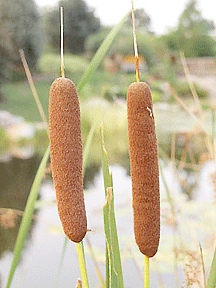
Volume XVII, Issue 36 # September 3 - September 9, 2009 |
 |
|
The Bay Gardener
 by Dr. Frank Gouin |
Gather Cattails While Ye May
For old time is a’flying
The next time you go by a swamp or wet area, take a look for cattails. Their flowers are a lush dark brown and they are smooth. Cattails make a wonderful plant for decorating in combination with fall foliage, pussy willows or other dry arrangements. But unless you harvest those cattails in late summer or early fall and properly treat them, you’ll miss out.

![]() As the cattail head matures, its color changes from rich brown to gray brown — just like us. And unless cattails are properly treated, they will rupture in the house during winter.
As the cattail head matures, its color changes from rich brown to gray brown — just like us. And unless cattails are properly treated, they will rupture in the house during winter.
To prevent the mess, some people spray them with hair spray in hopes that the lacquer will seal and prevent the cattails from maturing. But unless the lacquer is uniformly applied over the entire cattail head and sprayed at least twice, it is not likely to be 100 percent effective.
A guaranteed and easy way of sealing cattail heads is to collect the cattails from mid- to late-August to mid-September while they are at their best. Allow the cattails to dry for about a week in a well-ventilated area but under cover to prevent them from getting wet. Tie the cattail heads in loose bundles and hang them upside down. This is especially important if you are cutting the stems with foliage attached. You want the leaves to dry straight and not bent. After the heads have dried for several days, your sealant will better penetrate the flower head.
To seal the cattails, make a dilution of one part by volume Elmer’s white glue with nine parts by volume water. The diluted glue can either be placed in a piece of plastic pipe two inches in diameter and about two feet long with a cap at one end or in a shallow pan. Either dunk or roll the cattail in the diluted glue for a few seconds then hang upside down to dry. The diluted glue penetrates the flower head, thus preventing the seeds from maturing.
Depending on the humidity, the cattail heads will dry within three to four days. But it is best to allow them to hang upside down until you are ready to use them in making an arrangement.
What Makes a Good Evergreen Screen?
Q We would like to plant screen trees on our farm. We need to span 380 feet, possibly two alternating rows at 30-foot spacing. We were thinking Atlantic white cedars and thought a six- to seven-foot tree would give us partial coverage now with full coverage in the future. Does this sound logical? The harder question is who would have these on their plant availability list?
–Mike Dunn, Montpelier Farms: Upper Marlboro
A No one is currently growing Atlantic cedar in nurseries. It is available only as two- and three-year-old seedlings from Maryland Department of Natural Resources through your district forester. If you want an evergreen that tall, you will have to go to a commercial nursery and purchase arborvitae. Why not consider American holly or Foster holly?